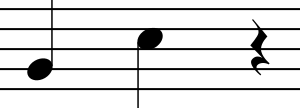
Quarter note



 = 2×
= 2× , etc.
, etc. | Drum pattern, accompanied by ride patterns of various duple lengths from | |||
A quarter note (American) or crotchet (/ˈkrɒtʃɪt/ KROTCH-it) (British) is a musical note played for one quarter of the duration of a whole note (or semibreve). Quarter notes are notated with a filled-in oval note head and a straight, flagless stem. The stem usually points upwards if it is below the middle line of the staff, and downwards if it is on or above the middle line. An upward stem is placed on the right side of the notehead, a downward stem is placed on the left (see image). The Unicode symbol is U+2669 (♩).

A quarter rest (or crotchet rest) denotes a silence of the same duration as a quarter note. It typically appears as the symbol ![]() , or occasionally, as the older symbol
, or occasionally, as the older symbol ![]() .[a][1]
.[a][1]

History
The note equates to the semiminima ('half minim') of mensural notation. The word "crotchet" comes from Old French crochet, meaning 'little hook', diminutive of croc, 'hook', because of the hook used on the note in black notation of the medieval period.

As the name implies, a quarter note's duration is one quarter that of a whole note, half the length of a half note, and twice that of an eighth note. It represents one beat in a bar of 4
4 time. The term "quarter note" is a calque (loan-translation) of the German term Viertelnote.

In the Romance languages of Catalan, French, Galician, and Spanish, the name of this note and its equivalent rest is derived from the Latin negra meaning 'black'—as the semiminima was the longest note to be colored in mensural white notation. This is still true of the note's modern form. The Bulgarian, Chinese, Croatian, Czech, Japanese, Korean, Norwegian, Polish, Russian, Serbian and Slovak names mean "quarter" (for the note) and "quarter's pause" (for the rest).

See also
Notes
- ^ Examples of the older symbol are found in English music up to the late 19th century, e.g. W. A. Mozart Requiem Mass, vocal score ed. W. T. Best, pub. London: Novello & Co. Ltd. 1879.
References
- ^ Rudiments and Theory of Music Associated Board of the Royal Schools of Music, London 1958. I,33 and III,25. The former section shows both forms without distinction, the latter the "old" form only. The book was the Official ABRSM theory manual in the UK up until at least 1975. The "old" form was taught as a manuscript variant of the printed form.
See what we do next...
OR
By submitting your email or phone number, you're giving mschf permission to send you email and/or recurring marketing texts. Data rates may apply. Text stop to cancel, help for help.
Success: You're subscribed now !
